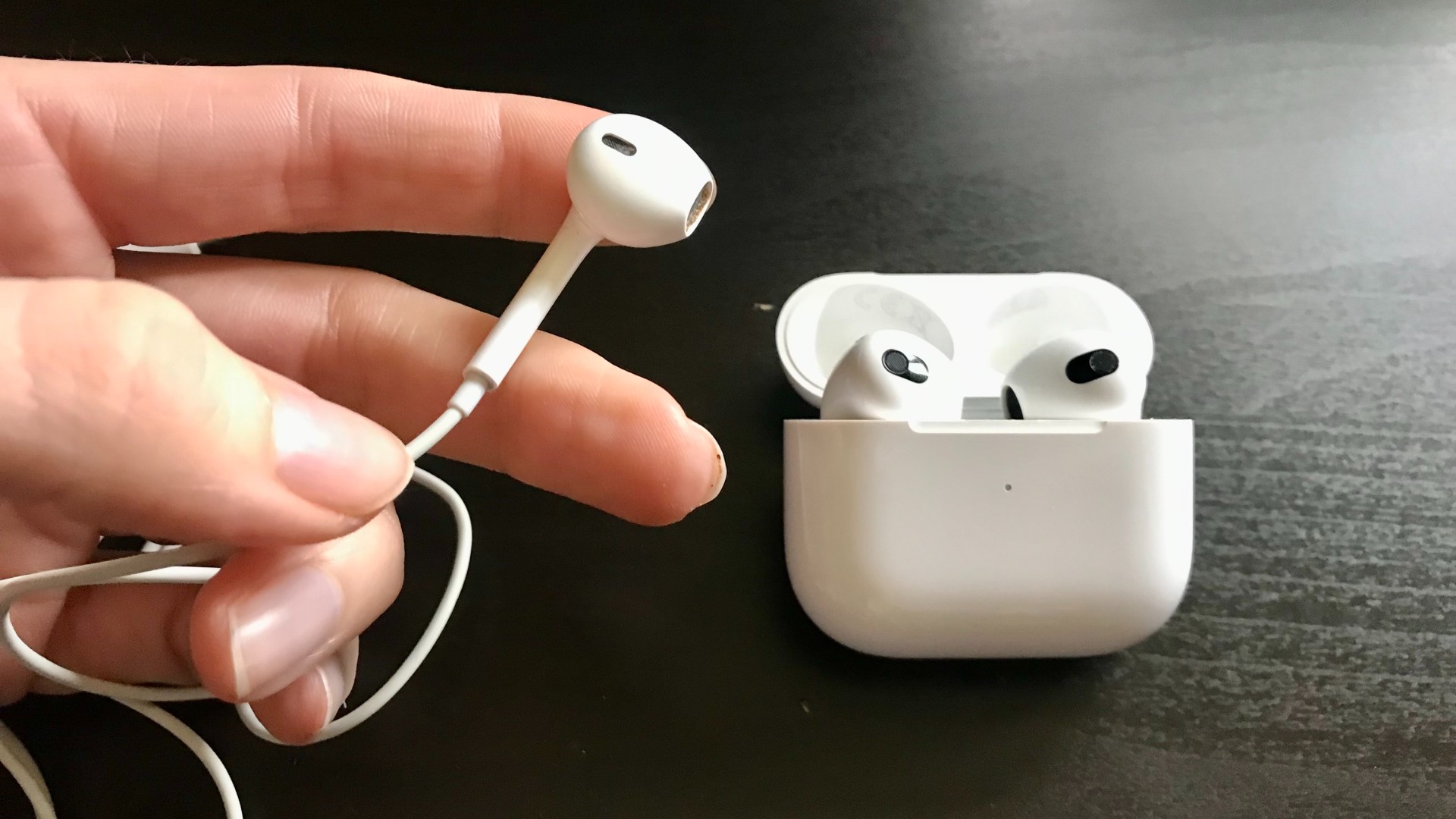In the photo above, I emphatically believe that the budget Apple product on the left will greatly outlive the one on the right, even though the Cupertino giant’s most affordable listening gear no longer comes bundled with any Apple devices. Furthermore, having spent a significant amount of time with each set of Apple earbuds, I still think the option on the left is a better bet, hands down.
Before you ask, yes, I also have the set with the 3.5mm connection for my vintage iPod setup and other hi-res digital music player – and the separate Lightning dongle. These wonderful wired beasts are often dotted around my person, squirrelled away in pockets (I lost those neat square boxes a long time ago, where you had to snake the cable around in a halo to frame the earpieces) bags and coats because why not? It’s nigh on impossible to lose an earpiece, they were once free with your iPhone and even now, you’ll pay just $30 for Apple’s less-sexily named but supremely functional EarPods.
Apple EarPods have a feature you won’t find on other AirPods…

No, you won’t get quick-pairing – because you don’t need any pairing here. Plug them in and you’re good to go, which means no waiting sans musique while the little things charge in their battery-pack nest. As long as there’s juice in your phone, so shall you have music when you own EarPods.
But that’s not the feature I’m talking about. What do you get with Apple’s EarPods that you won’t find on any AirPods except Apple’s flagship (and let’s face it, prohibitively expensive) AirPods Max? On-device volume control, that’s what.
Thanks to that easy-to-find clicker by your chest as you wear them, you get a built-in mic, reliable playback control, access to Siri and dedicated volume buttons. Now, try to tweak the volume of your music by tapping your AirPods (2019), or by squeezing the force sensor on the AirPods Pro and even the newest AirPods 3. No joy, which means digging your phone out of your bag to turn your music up on a packed train. Interesting, considering the price hike for wireless ‘convenience’…
Apple EarPods: the only Apple headphones that support Apple Music Lossless
As you can probably guess, herein lies the crux of the matter – OK, aside from the fact that you have to try very hard to lose one EarPod on a train, whereas most of us have lost at least one AirPod to our daily commute, puddle, sprint interval or hungry pet.
When Apple Music casually rolled out two higher resolution audio tiers (Lossless and Hi-Res Lossless) last year at no extra cost to its subscribers, it simultaneously garnered oodles of praise and a barrage of criticism. You see, Apple’s free upgrade to the quality of its music platform was great news to audiophiles and music lovers everywhere – except those who had just bought AirPods.
The fact is that the Bluetooth connection able to support Apple Music’s Lossless output (which is specified as starting at 16 bit/44.1kHz CD-quality and going up to 24-bit/48 kHz) does not yet exist. And that’s to say nothing of its Hi-Res Lossless offering, which improves the dynamic range and leading edges of your music all the way up to 24-bit/192kHz resolution.
Since all of Apple’s AirPods contain Bluetooth chipsets for wireless connectivity across the board, none of them can support Lossless – and they never will. Want to sneak around the issue by using your expensive AirPods Max with their wired connection? Sadly, no dice. Apple has explained this by saying, “When you play a 24-bit/48 kHz Apple Music lossless track from an iPhone into the AirPods Max using both the cable and Lightning dongle, the audio is converted to analog and then re-digitized to 48kHz. That re-digitization step is the reason that Apple can’t say you’re hearing pure lossless audio; it’s not an identical match to the source.”

Enter, then, the $30 Apple EarPods. These are a cheap and easy way to listen to Apple Music in Lossless and one that does not involve venturing outside Apple’s ecosystem. To make sure you’ve toggled on Lossless streaming, go to your iPhone’s settings, tap on Music, then scroll down to Audio and see the tab for Audio Quality. Click through, and then toggle on Lossless Audio at the top. Plug in those EarPods and you’re all set. How easy was that?
Does access to Lossless audio make a difference? This is subjective and delicate territory; none of us hears in quite the same way (remember the whole ‘Laurel, Yanny (opens in new tab)‘ debate a while back for starters?) but I am able to glean a little more detail through the dynamic range in most tracks. Do not misunderstand me: Apple’s EarPods are far from perfect when it comes to sonic deliverance and they are not an audiophile-grade product. But neither are Apple’s AirPods lineup. If you want a truly hi-res, audiophile experience from your device, add a DAC and move further up the wired food chain, you’ll soon see what I mean, but I maintain that for such a nominal outlay the EarPods are unbeaten within Apple’s earphone output.
If you like the fit of Apple’s bijou AirPods, you’ll certainly like the fit of its wired counterparts – it is the design upon which the once-novel wire-free AirPod driver housing was built. And although there’s no Find My support (they’re $30, it’s not the end of the world) or noise-cancellation in EarPods, you will likely not miss it. These are a rugged and street-savvy set of in-ears that allow some external sounds in – sensible, really – and won’t let you down.
Until Apple can make the wireless in- or over-ears capable of matching their cheap wired counterparts via support for the company’s own upgraded streaming platform, I find it hard to argue the case for buying into AirPods. For now, the trade off for Lossless content is an occasional cable snag on a door handle. And I’ll take it, thanks.




